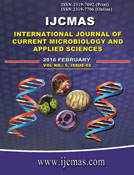


 National Academy of Agricultural Sciences (NAAS)
National Academy of Agricultural Sciences (NAAS)

|
PRINT ISSN : 2319-7692
Online ISSN : 2319-7706 Issues : 12 per year Publisher : Excellent Publishers Email : editorijcmas@gmail.com / submit@ijcmas.com Editor-in-chief: Dr.M.Prakash Index Copernicus ICV 2018: 95.39 NAAS RATING 2020: 5.38 |
A bacterial strain, B12, proficient in decolourizing commercial dye - Reactive Blue 160 (RB160) was isolated from the soil sample collected from a textile industry. Phenotypic characterization and phylogenetic analysis of the 16S rDNA sequence indicated that the bacterial strain belonged to the genus Microbacterium. Bacterial isolate B12 showed 96% decolourization of RB160 at the concentration of 250 mg/l under microaerobic conditions with temperature 35 ± 2°C and pH 5.0 in 24 h. The decolourization efficiency of isolate B12 was improved by using physical and chemical mutagens, the mutant strain offered 12 h reduction in time required for the complete decolourization by wild strain when exposed to 30 sec of UV radiation and 0.5µg/ml of acridine orange. The laccase and reductase enzymes cleaved RB160 and metabolised the degraded product, the different intermediates were identified using HPLC and LC-MS. The phytotoxicity studies confirmed that intact RB160 was more toxic than dye degraded intermediates. Microbacterium sp. B12 was found competent to degrade RB160 containing textile industry effluents showing the usefulness of the organism for possible commercial application.
 |
 |
 |
 |
 |